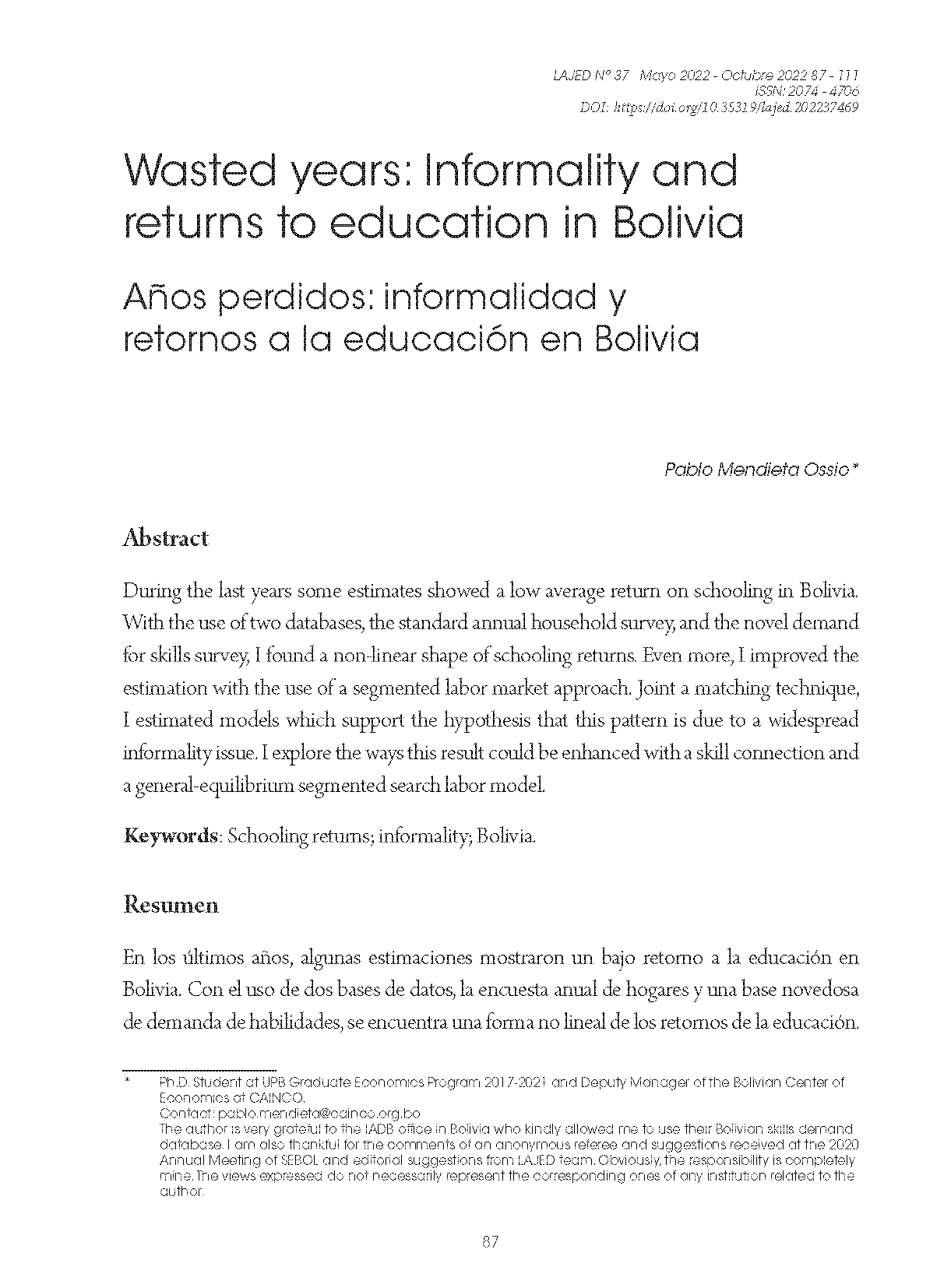Wasted years: Informality and returns to education in Bolivia
DOI:
https://doi.org/10.35319/lajed.202237469Keywords:
Schooling returns, informality, BoliviaAbstract
During the last years some estimates showed a low average return on schooling in Bolivia. With the use of two databases, the standard annual household survey, and the novel demand for skills survey, I found a non-linear shape of schooling returns. Even more, I improved the estimation with the use of a segmented labor market approach. Joint a matching technique, I estimated models which support the hypothesis that this pattern is due to a widespread informality issue. I explore the ways this result could be enhanced with a skill connection and a general-equilibrium segmented search labor model.
Downloads
References
Andersen, L. (2016, June 13). Does education pay in Bolivia? Inesad Development Roast. https://inesad.edu.bo/developmentroast/2016/06/does-education-pay-in-bolivia/
Bassi, M., Busso, M., Urzua, S. & Vargas, J. (2012) Disconnected: Skills, Education, and Employment in Latin America. Inter-American Development Bank. https://publications.iadb.org/en/disconnected-skills-education-and-employment-latin-america
Bobba, M., Flabbi, L. & Levy, S. (2018). Labor Market Search, Informality and Schooling Investments (IDB Working Paper Series Nº 863). https://publications.iadb.org/en/labor-market-search-informality-and-schooling-investments
Caliendo, M. & Kopeinig, S. (2008). Some Practical Guidance for the Implementation of Propensity Score Matching. Journal of Economic Surveys, 22(1), 31-72. https://doi.org/10.1111/j.1467-6419.2007.00527.x
Card, D. & Lemieux, T. (2001). Can Falling Supply Explain the Rising Return to College for Younger Men? A Cohort-Based Analysis. The Quarterly Journal of Economics, 116(2), 705-746. https://www.jstor.org/stable/2696477
Cramer, J. S. (2003) Logit Models from Economics and other Fields. Cambridge University Press.
Glewwe, P. (1992). The Three-Choice Multinomial Probit With Selectivity Corrections. Econometric Theory, 8(2), 302-304. https://www.jstor.org/stable/3532448
Gunther, I. & Launov, A. (2006). Competitive and Segmented Informal Labor Markets (IZA Discussion Papers N° 2349). https://docs.iza.org/dp2349.pdf
Heckman, J., Lochner, L. & Todd. P. (2006). Earnings Functions, Rates of Return and Treatment Effects: The Mincer Equation and Beyond. In E. Hanushek & F. Welch (eds.), Handbook of the Economics of Education (pp. 307-458). Elsevier. https://doi.org/10.1016/S1574-0692(06)01007-5
Heckman, J. (1979). Sample Selection Bias as a Speciffication Error. Econometrica, 47(1), 153-161. https://www.jstor.org/stable/1912352
Mincer, J. (1974). Schooling , Experience, and Earnings. National Bureau of Economic Research. https://econpapers.repec.org/bookchap/nbrnberbk/minc74-1.htm
Narayanan, A. (2015). Informal employment in India: Voluntary choice or a result of labor market segmentation? Indian Journal of Labour Economics, 58(1), 119-167. https://doi.org/10.1007/s41027-015-0009-9
Solon, G., Haider, S. & Wooldridge, J. (2015). What Are We Weighting For? Journal of Human Resources, 50(2), 301-316. https://doi.org/10.3368/jhr.50.2.301
Urquidi, M. (2015). ¿Es suficiente estudiar para lograr un buen trabajo? Factor Trabajo. https://goo.gl/yk4yGM
Vargas, J.P.M. & Garriga, S. (2015). Explaining inequality and poverty reduction in Bolivia (IMF Working Papers 15/265). https://www.imf.org/external/pubs/ft/wp/2015/wp15265.pdf
Velasco, D. (2015). Informal Economy in Bolivia: Analysis, Evaluation and Quantification Based on Cash Monetary Effective Demand Approach (period 1994-2014). Investigación & Desarrollo, 15(2), 76-89. https://www.upb.edu/sites/default/files/adjuntos/7-I&D215-Velasco-Abs_0.pdf
Villarroel, P. & Hernani, W. (2011). ¿La educación todavía paga? La disminución de retornos a la educación en la Bolivia urbana (Technical report). Fundación ARU.
Villarroel, P., Hernani, W. & Eid, A. (2012). Entrepreneurship and economic mobility. a case of study of Bolivia (Technical report). Fundación ARU.

Downloads
Published
How to Cite
Issue
Section
License
Copyright (c) 2022 Latin American Journal of Economic Development

This work is licensed under a Creative Commons Attribution-NonCommercial 4.0 International License.





